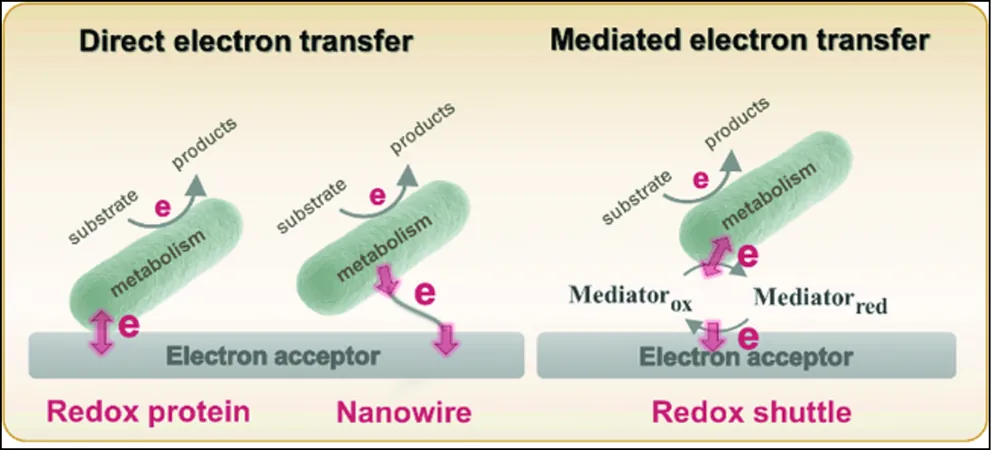
Unveiling the Secrets of Microbial Electron Transfer in the Human Gut: What You Need to Know!
2024-10-07
Author: Siti
Introduction
In a groundbreaking discussion, researchers Gratian Ting and Arpita Bose from Washington University in St. Louis shed light on a remarkable phenomenon occurring within our bodies: extracellular electron transfer (EET) in the human gastrointestinal tract. The implications of this discovery could change our understanding of gut health and the rich microbial life present within us.
The Gut Microbiome: An Incredible Ecosystem
Did you know that our gut microbiome houses an astonishing number of bacteria, estimated at hundreds of trillions? This vast ecosystem rivals the total number of cells in the human body, highlighting its incredible diversity and importance. But what influences this delicate balance? Two significant factors come into play: the characteristics of the host and dietary habits. While disruptions in gut processes can lead to cell death and dysbiosis—a state of microbial imbalance—diet often plays a far more influential role.
Dietary Impact on Gut Health
Dietary practices differ immensely across cultures, influenced by moral, economic, and personal choices, and can significantly affect gut microbial health. These microorganisms play a critical role in metabolizing organic compounds for energy, necessitating the transfer of electrons to electron acceptors. In particular, the small intestine is home to facultatively anaerobic bacteria that thrive on the unique oxygen levels provided by the human body through respiration and circulation.
Electrochemically Active Gut Bacteria
Recent studies have identified certain gut bacteria, such as *Faecalibacterium prausnitzii*, as electrochemically active, capable of utilizing EET. This bacterium is not only one of the most abundant commensal bacteria in the colon, but it also possesses potent anti-inflammatory properties. A decrease in *F. prausnitzii* numbers has been linked to inflammatory bowel diseases, affirming its critical role in maintaining gut health. As a prominent butyrate producer, *F. prausnitzii* plays a pivotal role in reducing inflammation in the intestinal mucosa.
Survival Mechanism of *F. prausnitzii*
Surprisingly, while *F. prausnitzii* is a strict anaerobe and sensitive to oxygen, it has developed the ability to tolerate low oxygen levels through extracellular electron transfer. By using flavins and thiols to facilitate EET to oxygen, it can thrive at the oxic-anoxic interfaces of the gut, mitigating oxidative stress and promoting a healthier gut environment.
Implications for Probiotics
The implications of EET extend beyond our gut health. Probiotic strains such as *Lactobacillus plantarum WCFS1* and *Lacticaseibacillus rhamnosus GG*, commonly found in over-the-counter supplements, exhibit similar capabilities. They have been shown to decrease proinflammatory cytokine production and enhance epithelial barrier function. Notably, *L. plantarum* can generate electrical currents and reduce iron(III) through EET, leading to increased ATP production and an improved NAD+/NADH ratio.
Complexities of Microbial Activities
This exciting realm of research reveals that the EET phenomenon may enhance the ability of probiotic bacteria to adhere to intestinal cells, boosting their effectiveness in promoting gut health. However, it's essential to note that bacterial EET activity isn’t always beneficial. The balance between various microbial activities is complex and can have variable impacts on gut health.
Conclusion
In conclusion, the growing understanding of microbial extracellular electron transfer in the human gastrointestinal tract reveals a captivating intersection of microbiology, nutrition, and health. As research continues to evolve, these insights could pave the way for innovative treatments and dietary strategies to enhance our gut health and overall well-being. The next time you think about your gut microbiome, remember that a rich world of microbial life is working hard to keep you healthy!

 Brasil (PT)
Brasil (PT)
 Canada (EN)
Canada (EN)
 Chile (ES)
Chile (ES)
 España (ES)
España (ES)
 France (FR)
France (FR)
 Hong Kong (EN)
Hong Kong (EN)
 Italia (IT)
Italia (IT)
 日本 (JA)
日本 (JA)
 Magyarország (HU)
Magyarország (HU)
 Norge (NO)
Norge (NO)
 Polska (PL)
Polska (PL)
 Schweiz (DE)
Schweiz (DE)
 Singapore (EN)
Singapore (EN)
 Sverige (SV)
Sverige (SV)
 Suomi (FI)
Suomi (FI)
 Türkiye (TR)
Türkiye (TR)